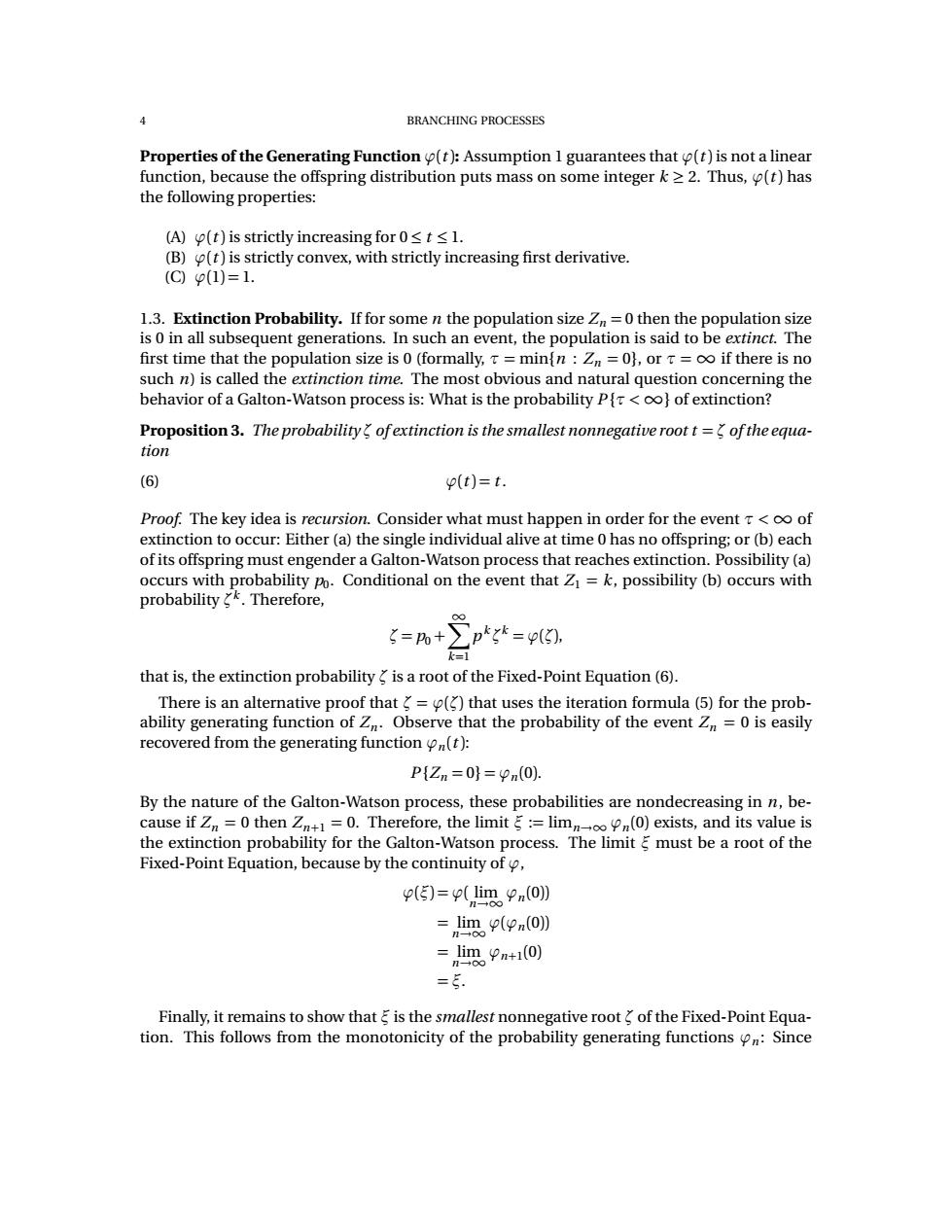正在加载图片...

BRANCHING PROCESSES Properties of the Generating Function (t):Assumption 1 guarantees that (t)is not a linear function,because the offspring distribution puts mass on some integer k >2.Thus,(t)has the following properties: (A)p(t)is strictly increasing for0≤t≤l. (B)(t)is strictly convex,with strictly increasing first derivative. (C)p(1)=1. 1.3.Extinction Probability.If for some n the population size Zn=0 then the population size is 0 in all subsequent generations.In such an event,the population is said to be extinct.The first time that the population size is 0(formally,=min{n:Zn=0},or =oo if there is no such n)is called the extinction time.The most obvious and natural question concerning the behavior of a Galton-Watson process is:What is the probability P{<oo}of extinction? Proposition 3.The probability ofextinction is the smallest nonnegative root t=of the equa- tion (6) (t)=t. Proof.The key idea is recursion.Consider what must happen in order for the event t<oo of extinction to occur:Either(a)the single individual alive at time 0 has no offspring;or(b)each of its offspring must engender a Galton-Watson process that reaches extinction.Possibility(a) occurs with probability po.Conditional on the event that Z1=k,possibility (b)occurs with probability.Therefore, =%+∑pgt=pg, k=1 that is,the extinction probability is a root of the Fixed-Point Equation(6). There is an alternative proof that =(that uses the iteration formula(5)for the prob- ability generating function of Zn.Observe that the probability of the eventZn=0 is easily recovered from the generating function n(t): P{Zm=0}=pn(0). By the nature of the Galton-Watson process,these probabilities are nondecreasing in n,be- cause if Zn=0 then Zn+1=0.Therefore,the limit:=lim(0)exists,and its value is the extinction probability for the Galton-Watson process.The limit must be a root of the Fixed-Point Equation,because by the continuity of p(ξ)=p(1impn(0) n+00 =lim (n(0)) n+0∞ =lim n+1(0) = Finally,it remains to show that is the smallest nonnegative root of the Fixed-Point Equa- tion.This follows from the monotonicity of the probability generating functions n:Since4 BRANCHING PROCESSES Properties of the Generating Function ϕ(t ): Assumption 1 guarantees that ϕ(t ) is not a linear function, because the offspring distribution puts mass on some integer k ≥ 2. Thus, ϕ(t ) has the following properties: (A) ϕ(t ) is strictly increasing for 0 ≤ t ≤ 1. (B) ϕ(t ) is strictly convex, with strictly increasing first derivative. (C) ϕ(1) = 1. 1.3. Extinction Probability. If for some n the population size Zn = 0 then the population size is 0 in all subsequent generations. In such an event, the population is said to be extinct. The first time that the population size is 0 (formally, τ = min{n : Zn = 0}, or τ = ∞ if there is no such n) is called the extinction time. The most obvious and natural question concerning the behavior of a Galton-Watson process is: What is the probability P {τ <∞} of extinction? Proposition 3. The probability ζ of extinction is the smallest nonnegative root t = ζ of the equation (6) ϕ(t ) = t . Proof. The key idea is recursion. Consider what must happen in order for the event τ < ∞ of extinction to occur: Either (a) the single individual alive at time 0 has no offspring; or (b) each of its offspring must engender a Galton-Watson process that reaches extinction. Possibility (a) occurs with probability p0 . Conditional on the event that Z1 = k, possibility (b) occurs with probability ζ k . Therefore, ζ = p0 + X∞ k=1 p k ζ k = ϕ(ζ), that is, the extinction probability ζ is a root of the Fixed-Point Equation (6). There is an alternative proof that ζ = ϕ(ζ) that uses the iteration formula (5) for the probability generating function of Zn . Observe that the probability of the event Zn = 0 is easily recovered from the generating function ϕn (t ): P {Zn = 0} = ϕn (0). By the nature of the Galton-Watson process, these probabilities are nondecreasing in n, because if Zn = 0 then Zn+1 = 0. Therefore, the limit ξ := limn→∞ ϕn (0) exists, and its value is the extinction probability for the Galton-Watson process. The limit ξ must be a root of the Fixed-Point Equation, because by the continuity of ϕ, ϕ(ξ) = ϕ( limn→∞ ϕn (0)) = limn→∞ ϕ(ϕn (0)) = limn→∞ ϕn+1 (0) = ξ. Finally, it remains to show that ξ is the smallest nonnegative root ζ of the Fixed-Point Equation. This follows from the monotonicity of the probability generating functions ϕn : Since